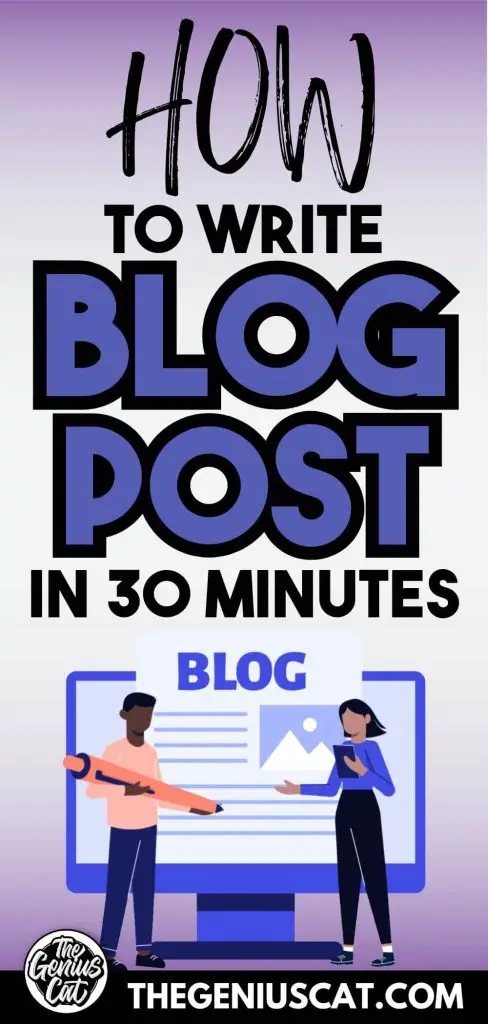Last updated on 5th July, 2024 at 02:56 pm
Heads Up: For the sake of transparency, this post might contain affiliate links. If a sale is made, I will receive a small commission (at no additional charge for you), which helps keep the lights on and helps feed my cats. Please read our disclosure policy for more information.
How to Write a Blog Post Fast: Recognizing the significance of crafting blog content swiftly is crucial for any blogger.
As a blogger, I understand the importance of writing blog posts efficiently without sacrificing quality.
Deadlines can be daunting, and a slow writing process can hinder productivity.
In this post, I will share valuable tips and strategies specifically focused on ‘how to write a blog post fast‘ while upholding the highest quality standards.
Whether you’re a seasoned writer or just starting, these techniques will help you meet your content goals efficiently.
- Plan Your Blog Post for Efficient Writing
- Get Paid to Do Simple Chat Jobs Online: $30/Hour
- Trust Your Pre-Planned Structure
- Start Writing! (Write Now, Edit Later)
- Create a Distraction-Free Writing Environment
- Establish a Writing Routine for Speed and Quality
- Streamline Your Writing Process with 3 Drafts
- Efficient Editing for Faster Writing
- Embrace Progress Over Perfection in Your Writing
- Embrace Imperfection and Cultivate Creativity
- Conclusion
Pin it to your favorite boards on Pinterest

When it comes to writing blogs, time is of the essence.
With the rise of AI blog writers, it’s become crucial for human writers to adapt and find ways to keep up with the pace.
So, let’s dive into practical techniques to enhance your blog writing format and make you a faster writer.
Plan Your Blog Post for Efficient Writing
When it comes to writing blog posts quickly and efficiently, one of the most crucial steps is to plan your articles.
By laying out a clear structure and outline, you can streamline your writing process and save valuable time in the long run.
The easiest way that you can achieve this is by creating a content brief.
This document acts as a roadmap to ensure that you can produce a successful blog post.
The content brief ought to encompass various essential steps outlined below:
Step 1: Research Your Topic
A thorough research is essential. Gathering relevant information, statistics, and data will not only strengthen the credibility of your content but also provide valuable insights to your readers.
Start by exploring reputable sources within your industry or niche, such as academic journals, industry publications, or government websites.
These sources often provide reliable and up-to-date information that you can use to support your arguments and claims.
Step 2: Analysis of Competitor Blog Posts
Take the time to research and analyze your competitors’ blog posts. Identify how they cover the topic, their writing style, and any gaps or opportunities in their content. This analysis will help you differentiate your blog post and provide valuable insights to your readers.
Step 3: Keyword Research
Once you know what topic to write, next is to focus on keyword research. Identify primary and secondary keywords that are relevant to your topic and align with your target audience’s search intent. These keywords will serve as the foundation for optimizing your blog post for search engines.
Step 4: Blog Post Intent
Clearly define the objective of your blog post. Are you aiming to educate, entertain, persuade, or inform your readers? Understanding the intent behind your blog post will help you create content that resonates with your audience and achieves your desired outcome.
Step 5: Tone of Voice
Establishing the right tone of voice is crucial for maintaining consistency in your brand messaging. Determine whether your blog post should adopt a friendly, authoritative, conversational, or formal tone, depending on your target audience and the nature of your content.
Step 6: Create an Outline for Your Blog Post
Having a clear and organized outline is essential. An outline serves as a roadmap for your content, helping you structure your ideas and ensure a logical flow throughout your article.
To speed up the outline process, consider using an AI blog outline generator like Rytr. This tool can generate section headers and ideas based on your topic, saving you time and providing you with a starting point for your outline.
Simply input your main topic or keyword, and the AI will generate relevant section headings and bullet points for each section.
As you can see, planning your articles is essential for efficient writing.
By having a solid plan in place before you even start writing the first sentence, you can ensure that your thoughts are organized and that your article has a logical flow. This will not only save you time but also help maintain the coherence and quality of your content.
Get Paid to Do Simple Chat Jobs Online: $30/Hour
Get paid to work from home? Yes, please! It’s an online job that starts at $30 per hour. Click the “Learn More” button for more info.
- Work online from anywhere
- Set your own hours
- No experience required
Trust Your Pre-Planned Structure
Next, trust your pre-planned structure.
By outlining your article in advance, you create a roadmap that guides your writing process. This allows you to write freely without constantly second-guessing yourself or getting stuck in perfectionism.
When you have a clear and well-defined outline, you can focus on developing your ideas and arguments without losing momentum.
Trusting your structure gives you the confidence to write without overthinking, allowing your thoughts to flow more naturally onto the page.
By following your pre-planned outline, you avoid the need to constantly revise and reorganize your writing. This saves you time and allows you to make progress more quickly.
Instead of getting caught up in micro-editing during the writing process, you can focus on capturing your ideas and expanding on your main points.
Start Writing! (Write Now, Edit Later)
Now that you have your outline ready, it’s time to dive into writing your blog post. This is the stage where you flush out all your creative juice and let your ideas flow onto the page.
Don’t worry about grammar, spelling, or formatting just yet – the goal is to save time and streamline your writing process.
To achieve a concise writing style, aim for shorter sentences that convey essential information using pertinent adjectives.
This allows you to maintain clarity and convey your message efficiently. Remember, the goal is to write effectively without overwhelming your readers or yourself with unnecessary verbosity.
One thing I wish to share here is to set a timer for a specific amount of time, like 30 minutes or an hour, and challenge yourself to write as much as you can during that time.
You can also try using the Pomodoro technique, which involves working in short bursts of intense focus followed by short breaks.
Don’t get too caught up in the word count during the drafting stage. Aim for a rough draft of around 1,000 words, but don’t stress if you go over or under.
The important thing is to establish a strong foundation for your blog post. You can always refine and edit your writing later.
Create a Distraction-Free Writing Environment
When it comes to writing quickly and efficiently, creating a distraction-free writing environment is essential.
By eliminating distractions, you can focus all your energy and attention on the task at hand: writing.
To achieve this, there are a few simple steps you can take.
Minimize Digital Distractions
Start by uninstalling social media apps from your phone or using website blockers to limit access to distracting websites.
Putting your phone in flight mode or using connectivity-free devices can also help you stay focused.
By removing the temptation to check notifications or browse the internet, you can maintain a distraction-free writing session.
Create a Quiet Space
Find a quiet and comfortable space where you can concentrate without interruptions.
This could be a home office, a coffee shop, or even a secluded corner of your home. Make sure the area is well-lit and free from noise distractions.
You can use noise-canceling headphones or play calming background music to further enhance your focus.
Create Writing Rituals
Developing writing rituals can help signal your brain that it’s time to focus on writing. These rituals can be as simple as lighting a scented candle, brewing a cup of tea, or setting a specific writing playlist.
By consistently engaging in these rituals before each writing session, you’ll train your mind to enter a focused state more quickly.
Establish a Writing Routine for Speed and Quality
When it comes to writing blog posts quickly and maintaining high-quality content, establishing a writing routine is key.
A consistent routine helps you develop a rhythm and trains your mind to focus solely on the task at hand.
By dedicating specific time to writing and following a set routine, you can improve your writing speed and maintain the quality of your work.
Benefits of a Writing Routine
Having a writing routine offers several benefits.
Firstly, it helps eliminate procrastination by creating a sense of accountability and discipline. When you establish a routine, you are more likely to stick to your writing schedule and avoid distractions.
Secondly, a routine helps to separate administrative tasks from creative writing. By dedicating specific time solely to writing, you can fully immerse yourself in the content creation process without the interruption of other tasks.
Lastly, a routine helps reduce writer’s block by training your mind to be in writing mode at specific times. This allows ideas to flow more freely, making the writing process more efficient.
Tips for Establishing a Writing Routine
To establish an effective writing routine, it’s important to consider your personal preferences and productivity patterns.
Here are some tips to help you get started:
- Set a specific time for writing: Choose a time of day when you feel most focused and creative. It could be early in the morning, during lunch breaks, or in the evening. Stick to this schedule consistently to develop a habit.
- Create a dedicated writing space: Designate a specific area for writing where you feel comfortable and free from distractions. It could be a quiet corner in your home, a library, or a cozy café.
- Follow rituals: Establishing rituals before starting your writing session can help signal to your brain that it’s time to focus. This could be making a cup of coffee, lighting a scented candle, or doing a quick meditation.
- Set realistic goals: Determine the amount of writing you aim to accomplish during each session. Setting achievable goals will help you stay motivated and keep your writing routine consistent.
- Experiment and adjust: Finding the right routine may require some trial and error. Be open to experimenting with different schedules and approaches to see what works best for you. Adjust your routine as needed to optimize your productivity.
Streamline Your Writing Process with 3 Drafts
Implementing a 3-draft approach can be a game-changer.
This method allows you to streamline your writing process, ensuring that you produce well-structured and polished articles without sacrificing speed or quality.
First Draft: Free-Wheeling Creativity
During the first draft, let your creativity flow freely. Adhere to your pre-defined plan and follow your outlined structure, but don’t get caught up in examining every sentence or perfecting every detail.
The goal of this draft is to get your ideas down on paper, capturing the essence of your message without overthinking or excessive revisions.
Second Draft: Thorough Editing
In the second draft, shift your focus to editing. This is the time to enhance your writing style, combat any wordiness, and tighten up your arguments.
Pay attention to sentence structure, grammar, and punctuation. Use grammar and wordiness apps to help you eliminate mistakes and unnecessary decoration.
By devoting this draft to thorough editing, you can refine your article, making it more concise and impactful.
Third Draft: Global Review and Fine-Tuning
The third and final draft is your opportunity to review your article globally and fine-tune its details. Take a step back and look at the big picture.
Check for coherence and smooth transitions between paragraphs and sections. Ensure that each point contributes to your main message and that the overall flow of the article is logical and engaging.
By conducting this comprehensive review, you can ensure a high-quality, well-structured final article.
Efficient Editing for Faster Writing
It’s important to edit with no mercy.
Developing an efficient editing routine can help streamline your writing and save valuable time.
Here are some tips to make your editing process more efficient:
- Use grammar and wordiness apps: Utilize tools like Grammarly or Hemingway Editor to quickly identify and correct grammar mistakes, wordiness, and other writing issues. These tools can help you eliminate errors and improve the overall quality of your writing.
- Focus on the main points: Highlight the main arguments and key points of your article. Compare them with your initial structure to ensure that each point is developed and contributes to the main message. This process helps you stay on track and maintain coherence throughout your writing.
- Eliminate unnecessary content: Cut out any unnecessary or repetitive information that doesn’t add value to your article. The goal is to be concise and impactful, so remove any fluff or redundant sentences that may slow down the reading experience. Your readers will appreciate the clarity and brevity of your writing.
By practicing efficient editing techniques, you can become a faster writer and produce high-quality content.
Remember to prioritize speed and conclusiveness during the editing process, focusing on eliminating mistakes and improving clarity.
With time and practice, you’ll develop an editing routine that suits your writing style and goals.
Embrace Progress Over Perfection in Your Writing
When it comes to writing, it’s easy to get caught up in the quest for perfection. We strive to create flawless sentences and impeccable prose, often at the expense of our productivity.
But what if we shift our focus from perfection to progress?
Embracing progress over perfection allows us to let go of unrealistic expectations and embrace the imperfections in our writing. It gives us the freedom to write without constantly second-guessing ourselves or getting stuck in the pursuit of lawlessness.
Instead, we can focus on continuously improving our skills and producing consistent, high-quality content.
Continuous improvement is the key to becoming a faster writer. By recognizing that there is always room for growth and learning, we can approach each new article with a mindset of exploration and development.
This mindset encourages us to experiment with different writing techniques, take risks, and learn from our mistakes. It’s through this process of trial and error that we evolve as writers and find our unique voice.
Embrace Imperfection and Cultivate Creativity
Perfectionism often stifles creativity. It creates a fear of failure that holds us back from taking risks and exploring new ideas. By embracing imperfection, we can break free from the constraints of perfection and allow our creativity to flourish.
When we let go of the need to be perfect, we open ourselves up to new possibilities. We become more willing to experiment with different writing styles, explore unconventional topics, and approach our work with a sense of curiosity.
Embracing imperfection frees us from the fear of judgment and allows us to fully express ourselves through our writing.
Conclusion
Writing blog posts faster without compromising on quality is a crucial skill for efficient content creation.
By implementing the tips and strategies discussed in this article, you can significantly improve your writing speed and produce high-quality content consistently.
With practice and discipline, you will become a more efficient and effective writer, achieving your content goals with ease.
Enjoyed what you just read? Remember to share it and follow me on Pinterest for more!




